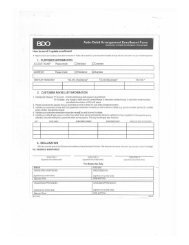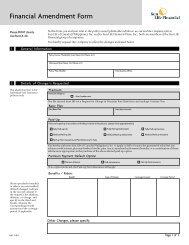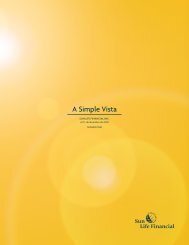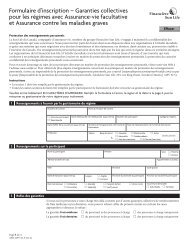2007 Annual Report - Sun Life Financial
2007 Annual Report - Sun Life Financial
2007 Annual Report - Sun Life Financial
Create successful ePaper yourself
Turn your PDF publications into a flip-book with our unique Google optimized e-Paper software.
FINANCIAL ASSEtS<br />
<strong>Financial</strong> assets are recognized in the Companies’ financial statements when the Companies become<br />
a party to the contractual provisions of the instrument. <strong>Financial</strong> assets are recognized initially at<br />
fair value. Transaction costs are included in the initial measurement of all financial assets, except<br />
for investments classified as at fair value through profit or loss. In a regular way purchase or sale,<br />
financial assets are recognized and derecognized, as applicable, using settlement date accounting.<br />
<strong>Financial</strong> assets are derecognized by the Companies when:<br />
a. the contractual rights to the cash flows from the financial asset expire; or<br />
b. the contractual rights to receive cash flows have been transferred.<br />
Other than cash and receivables, the Companies’ financial assets include investments at fair value<br />
through profit or loss and held-to-maturity investments.<br />
Investments at fair value through profit or loss<br />
<strong>Financial</strong> assets are classified as investments at fair value through profit or loss when they are<br />
acquired for trading or are designated upon initial recognition. Unless designated and considered as<br />
effective hedging instruments, derivatives are classified at fair value through profit or loss. <strong>Financial</strong><br />
assets under this category are carried at fair value with gains and losses arising from changes in fair<br />
value being included in the profit or loss for the period.<br />
<strong>Financial</strong> assets at fair value through profit or loss are stated at fair value, with any resultant gain or<br />
loss recognized in profit or loss. The net gain or loss recognized in statements of income incorporates<br />
any dividend or interest earned on the financial asset.<br />
Loans and receivables<br />
Loans that have fixed or determinable payments that are not quoted in an active market are<br />
classified as loans and receivables. Loans and receivables are measured at amortized cost using<br />
the effective interest method, less any impairment. Interest income is recognized by applying<br />
the effective interest rate, except for short-term receivables the recognition of interest would be<br />
immaterial.<br />
Held-to-maturity investments<br />
Held-to-maturity investments are non-derivative financial assets with fixed or determinable<br />
payments that the Companies intend and are able to hold to maturity and that do not meet the<br />
definition of loans and receivables and are not designated on initial recognition as assets at fair<br />
value through profit or loss or as available-for-sale. Held-to-maturity investments are measured at<br />
amortized cost.<br />
The effective interest method is a method of calculating the amortized cost of a financial asset and of<br />
allocating interest income over the relevant period. The effective interest rate is the rate that exactly<br />
discounts estimated future cash receipts through the expected life of the financial asset, or, when<br />
appropriate, a shorter period.<br />
IMPAIRMENt OF FINANCIAL ASSEtS<br />
The Companies assess at each balance sheet date whether there is any objective evidence that a<br />
financial asset or group of financial assets is impaired.<br />
<strong>2007</strong> <strong>Annual</strong> <strong>Report</strong> 33
















